QLC Goes To 8TB: Samsung 870 QVO and Sabrent Rocket Q 8TB SSDs Reviewed
by Billy Tallis on December 4, 2020 8:00 AM EST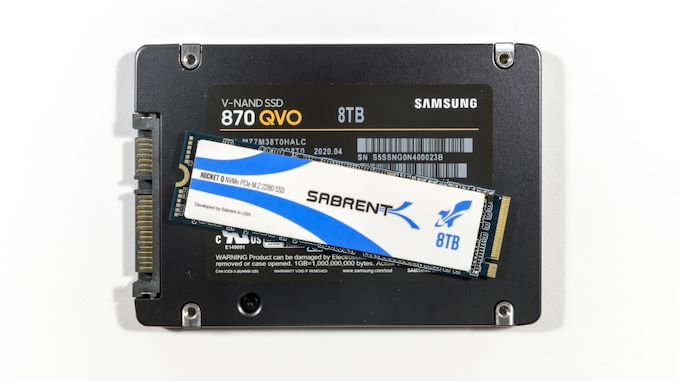
Flash memory prices have been on a downward trajectory for years. A decade ago, this trend was helping SSDs establish a foothold in the consumer market—largely for enthusiasts. Now, SSDs have taken over as the default storage medium for consumer PCs and further advances in flash memory are no longer pushing consumer SSDs into new product segments. Instead, cheaper flash is driving an increase in SSD capacity.
That growth in drive capacity has not been steady. For both technical and marketing reasons, consumer SSD capacities stick close to powers of two. The first 2TB consumer SSDs started to show up in 2015, and now 2TB options are common across all the SSD market segments. 4TB drives started to show up in 2018 but are still quite rare, and this year we've seen the first 8TB consumer SSDs.
Today we're looking at the first two consumer-oriented 8TB SSDs. The 8TB Samsung 870 QVO is a SATA drive from the brand that has been at the forefront of the past several capacity increases and leads the SSD market by most other measures. The other drive is the 8TB Sabrent Rocket Q, a M.2 NVMe drive from a brand that's working to stand out from the crowd of many other Phison partners. Unsurprisingly, both of these drives use four bit per cell QLC NAND flash memory which offers the lowest cost per GB and the highest per-die capacities currently available. QLC NAND generally puts SSDs into an entry-level market segment, but due to their extreme capacities these 8TB SSDs are still some of the most expensive drives in the consumer SSD market.
Sabrent Rocket Q 8TB
| Sabrent Rocket Q Specifications | |||||||
| Capacity | 500 GB | 1 TB | 2 TB | 4 TB | 8 TB | ||
| Form Factor | M.2 2280 single-sided PCIe 3 x4 |
M.2 2280 double-sided PCIe 3 x4 |
|||||
| Controller | Sabrent-branded Phison E12S | ||||||
| NAND Flash | Micron 1Tbit 96L 3D QLC | ||||||
| DRAM | Kingston DDR3 | ||||||
| Sequential Read (MB/s) | 2000 | 3200 | 3300 | ||||
| Sequential Write (MB/s) | 1000 | 2000 | 3000 | 2900 | |||
| Random Read IOPS (4kB) | 95k | 125k | 255k | 550k | 550k | ||
| Random Write IOPS (4kB) | 250k | 500k | 670k | 680k | |||
| Power Consumption (W) |
Read | 3.5 | 5.0 | 5.5 | 5.0 | 5.6 | |
| Write | 3.5 | 4.5 | 6.0 | 6.5 | 6.5 | ||
| Warranty | 5 years | ||||||
| Write Endurance | 120 TB 0.13 DWPD |
260 TB 0.14 DWPD |
530 TB 0.14 DWPD |
940 TB 0.13 DWPD |
1800 TB 0.13 DWPD |
||
| Current Retail Prices | $64.99 (13¢/GB) | $109.98 (11¢/GB) | $219.98 (11¢/GB) | $599.98 (15¢/GB) | $1299.99 (16¢/GB) | ||
The Sabrent Rocket Q is a bit unusual among QLC NVMe SSDs, and not just because it offers such high capacities. Most consumer QLC SSDs use fairly low-end SSD controllers rather than let the performance potential of a high-end controller be wasted on slow QLC NAND. But the Rocket Q uses the Phison E12, a familiar mainstay of the high-end NVMe market segment (but seen here in the more compact E12S packaging). This means the Rocket Q has an 8-channel controller at its disposal rather than just four channels, and that helps immensely at the higher capacities where there's enough flash to compensate for the low performance of QLC NAND.
The Rocket Q does cut corners a bit by using just one fourth of the DRAM we usually see on mainstream SSDs. That hurts a bit at the lower capacities (though nowhere near as much as a fully DRAMless design would), but is much less of a problem for this 8TB model: 2GB of DRAM is still plenty for the SSD to handle any typical consumer workload.
The Rocket Q lineup goes from 500GB to 8TB, but we generally consider QLC drives smaller than 1TB to be a poor alternative to DRAMless TLC drives. That's even more true for the Rocket Q, because the 500GB model can only use half of the Phison E12's 8 channels.
Sabrent has also introduced the Rocket Q4 as a partial successor. This uses the Phison E16 controller and brings PCIe 4 support and improved performance. However, the E16 is not yet (and may never be) available in a small package size like the E12S controller, so it is not yet practical for Sabrent and Phison to squeeze 8TB of QLC onto a PCIe gen4 M.2 drive.
Samsung 870 QVO 8TB
| Samsung 870 QVO Specifications | ||||||
| Capacity | 1 TB | 2 TB | 4 TB | 8 TB | ||
| Form Factor | 2.5" 7mm SATA | |||||
| Controller | Samsung MKX | |||||
| NAND Flash | Samsung 1Tbit 92L 3D QLC | |||||
| LPDDR4 DRAM | 1 GB | 2 GB | 4 GB | 8 GB | ||
| Max SLC Cache Size | 42 GB | 78 GB | 78 GB | 78 GB | ||
| Sequential Read | 560 MB/s | |||||
| Sequential Write |
SLC | 530 MB/s | ||||
| QLC | 80 MB/s | 160 MB/s | ||||
| Random Read IOPS (4kB) |
QD1 | 11k (SLC) 5k (QLC) |
11k (SLC) 5k (QLC) |
|||
| QD32 | 98k (SLC) 45k (QLC) |
98k (SLC) 74k (QLC) |
||||
| Random Write IOPS (4kB) |
QD1 | 35k (SLC) 22k (QLC) |
35k (SLC) 34k (QLC) |
|||
| QD32 | 88k (SLC) 22k (QLC) |
88k (SLC) 42k (QLC) |
||||
| Power Consumption |
Read | 2.1 W | 2.1 W | 2.2 W | 2.4 W | |
| Write | 2.2 W | 3.0 W | 3.2 W | 3.3 W | ||
| Idle | 30 mW | 30 mW | 35 mW | 45 mW | ||
| DevSlp | 3 mW | 4 mW | 7 mW | 10 mW | ||
| Warranty | 3 years | |||||
| Write Endurance | 360 TB 0.3 DWPD |
720 TB 0.3 DWPD |
1440 TB 0.3 DWPD |
2880 TB 0.3 DWPD |
||
| Current Retail Prices | $89.99 (9¢/GB) |
$199.99 (10¢/GB) |
$419.99 (10¢/GB) |
$899.99 (11¢/GB) |
||
We reviewed the Samsung 870 QVO when it first launched, but the 8TB capacity arrived a bit later. Other than the higher capacity, there's not much new to say about the 8TB model of their second-generation QLC SSD. It has twice the NAND and twice the DRAM and twice the total write endurance, but the same performance ratings and SLC cache sizes as the 2TB and 4TB models. Samsung's SATA SSD controller doesn't offer much potential for higher performance once all channels are populated with at least two NAND dies.
Compared to the Rocket Q, the Samsung 870 QVO has higher write endurance ratings both in terms of drive writes per day and total TB written. However, the Rocket Q comes with a 5 year warranty and the 870 QVO only has a 3 year warranty. The Samsung 870 QVO is far cheaper at these high capacities; NVMe SSD controllers are only a little bit more expensive than SATA SSD controllers, but lack of competition leaves Sabrent free to charge a much higher price per GB for their QLC NVMe product. Samsung's vertical integration probably helps them maintain decent profit margins even on their more competitively-priced drive.
QLC NAND's Impact on the Consumer SSD Market
The introduction of QLC NAND as a cheaper alternative to three bit per cell TLC NAND has not revolutionized consumer SSD affordability, but it has made higher SSD capacities practical. QLC NAND offers just a 33% increase in theoretical storage density, but in practice most QLC NAND is manufactured as 1024Gbit dies while TLC NAND is manufactured as 256Gbit and 512Gbit dies. This means that it is easier to fit much more flash into the same form factor using QLC than with TLC NAND. Indeed, the Sabrent Rocket Q is bumping up against the practical limits for a M.2 drive.
For drives with more commonplace capacities, QLC NAND has several distinct disadvantages. Storing more bits per physical memory cell requires more precise control over the voltage of each cell, and as a result writing to QLC NAND is much slower than writing to TLC NAND (reading is also a bit slower). That sensitivity to cell voltage also reduces the usable write endurance of QLC NAND before data retention becomes a problem. Drives using QLC NAND have to be rated for fewer drive writes per day (DWPD) in order to meet industry standards for data retention of a worn-out consumer SSD.
However, almost all of those downsides of QLC NAND can be mitigated with sheer capacity. The sequential transfer speed of a single die of NAND flash memory has never been particularly impressive, regardless of how many bits are stored per cell. These 8TB QLC drives use a total of 64 NAND flash dies each, which allows for a lot of parallelism in data transfers (though the SSD's controller becomes a bottleneck). SLC caching helps address most of the remaining performance problems, but when the SLC cache on a QLC drive runs out, the performance impact is much more severe than for TLC drives.
Write endurance ratings of 0.1 to 0.3 DWPD appear inferior to the 0.5 DWPD or more from good consumer TLC drives, but looking at endurance as a fraction of drive capacity perhaps isn't the most useful measure for these drives. Both of these 8TB QLC drives are warrantied for over 1TB of writes per day (over 2TB per day for the Samsung drive, but its warranty is only three years rather than five). Most consumer use cases for a multi-TB drive do not involve re-writing most of that data often. Large collections of games, movies and photos can use up the capacity of these 8TB drives, but such infrequently-modified data won't put much of a dent in the drive's total write endurance. A mere 3% of the capacity of these drives (240GB) is plenty to hold an OS and most data that will see frequent modification. Filling the rest of the drive with relatively static data won't hurt the drive's lifespan.
Who Needs 8TB SSDs?
A capacity of 8TB is a bit on the large side even for mechanical hard drives. Sure, consumer-oriented hard drive product lines are starting to go beyond 14TB, but average capacity sold is much lower. Many use cases for large drives don't require high performance. An 8TB SSD will offer significant noise and power efficiency advantages over an 8TB hard drive, but either one is adequate for storing a large movie collection. A mechanical hard drive is definitely preferable for long-term archival/backup duty, but an SSD has advantages for keeping data readily accessible.
That's especially true in a mobile setting, which may be where these 8TB drives make the most sense. Most desktops can accommodate several drives of lower capacity, and so far these 8TB drives carry a significant price premium on a $/GB basis compared to 1TB or 2TB models. But in a notebook, it's uncommon to have more than one drive bay/slot, and more than three is only found in machines that stretch the definitions of "notebook" and "portable". So the most sensible or plausible use cases we can imagine for these drives are scenarios that more or less fall into mobile workstation territory. But the sustained write speed of these drives will be a problem when it comes to ingesting uncompressed video even if performance is adequate for editing a large amount of video already residing on one of the drives, so these drives definitely aren't suitable for every scenario where multiple TBs of data are thrown around.
It's also easy to imagine other niche use cases for these drives where cost is of no object: a small form factor nearly-silent NAS, for example. (QLC performance doesn't matter if it sits behind a 1Gbps network bottleneck, and still isn't much of an issue even with a 10Gbps network.) But for today, we're going to evaluate these drives with our usual consumer SSD testing methodology.
The Competition
It's tricky deciding what to compare these 8TB drives against. The use of QLC NAND would traditionally flag these drives as low-end options. But their extreme capacity is unmatched by consumer TLC drives, and the raw cost of 8TB of NAND makes for a high-priced drive overall. Aside from QLC drives, most other low-end consumer SSDs are DRAMless TLC designs—and those product lines mostly top out at 1TB. We've included the Mushkin Helix and Toshiba BG4 as representatives of the DRAMless TLC NVMe market segment.
The largest consumer SSDs we have to compare against are Samsung's earlier 4TB SATA SSDs. We've included the 4TB 860 EVO. For some tests, we also have included results from a few enterprise drives: 8TB NVMe models from Intel and SK hynix, and 4TB SATA drives from Kingston and Samsung. These all use TLC NAND, but without SLC caching.
High-end consumer SSD product lines are starting to include more multi-TB capacities, but for now the largest high-end consumer NVMe drives we have on hand are a "mere" 2TB each: Samsung's 970 EVO Plus and the HP EX950.
| AnandTech 2018 Consumer SSD Testbed | |
| CPU | Intel Xeon E3 1240 v5 |
| Motherboard | ASRock Fatal1ty E3V5 Performance Gaming/OC |
| Chipset | Intel C232 |
| Memory | 4x 8GB G.SKILL Ripjaws DDR4-2400 CL15 |
| Graphics | AMD Radeon HD 5450, 1920x1200@60Hz |
| Software | Windows 10 x64, version 1709 |
| Linux kernel version 4.14, fio version 3.6 | |
| Spectre/Meltdown microcode and OS patches current as of May 2018 | |
- Thanks to Intel for the Xeon E3 1240 v5 CPU
- Thanks to ASRock for the E3V5 Performance Gaming/OC
- Thanks to G.SKILL for the Ripjaws DDR4-2400 RAM
- Thanks to Corsair for the RM750 power supply, Carbide 200R case, and Hydro H60 CPU cooler
- Thanks to Quarch for the HD Programmable Power Module and accessories
- Thanks to StarTech for providing a RK2236BKF 22U rack cabinet.


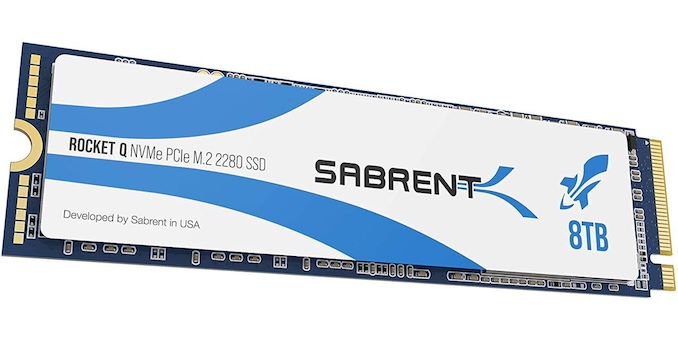
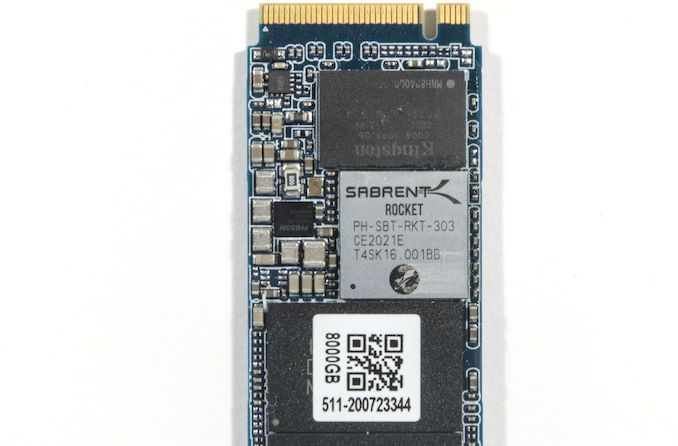
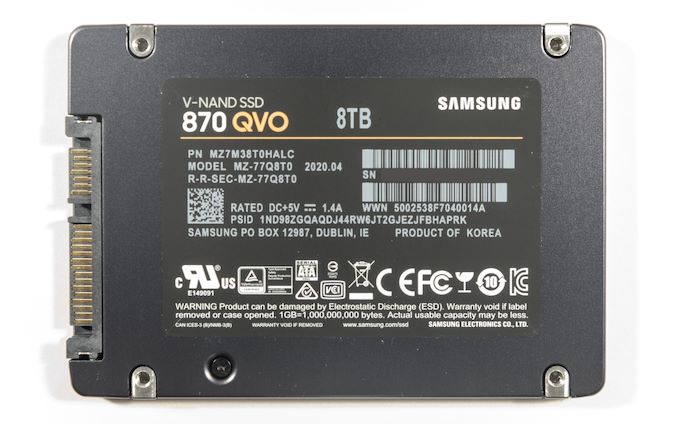
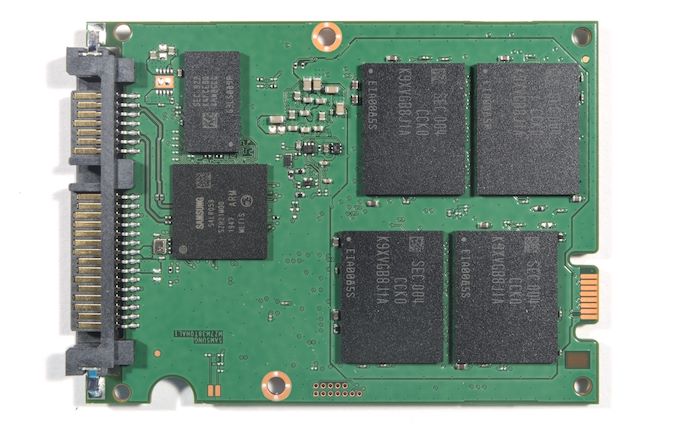














150 Comments
View All Comments
shabby - Friday, December 4, 2020 - link
Go home qlc ssd manufacturers, you're drunk!Oxford Guy - Friday, December 4, 2020 - link
The market doesn't care what we want. It's driven by the manufacturers. That's the way most of tech is because of duopoly, triopoly power and the high cost of owning fabs. They get to dictate to us which is not the way consumerist capitalism is supposed to work.Oxford Guy - Friday, December 4, 2020 - link
There is also consumer ignorance. Go to a site that pushes product, like slickdeals, and you won't find the type of NAND listed in the listing for their SSD "deals". Everything is just an "SSD". Manufacturers are counting on consumer ignorance.Zim - Saturday, December 5, 2020 - link
Not true. Every one of those deals has people saying no to QLC. People still buy it because it's cheap.SirDragonClaw - Saturday, December 5, 2020 - link
Not true. 99.9% of people wouldn't even know what QLC means.ahtoh - Sunday, December 6, 2020 - link
Not true. I'd say 50% at least. People who buy SSDs (or parts in general) are more educated and probably know what they're doing.s.yu - Sunday, December 6, 2020 - link
"Parts"Ah that actually makes it sound pretty sophisticated :)
at_clucks - Monday, December 7, 2020 - link
50% of people know what QLC means? Is that a joke? 50% of ATers don't understand what that means. Most consumers who even heard of the term think it's just another type of LC, the more LCs the better right? No, almost no consumer knows what that means, it's a tech spec, they may know it's not the best out there but that's it But if the price is good they won't care.Product listings are marketing fluff and BS sprinkled with plenty of concepts no regular user will even understand because they sound fancy (like TWD and ECC), they will list stuff that the average consumer can understand and relate to - capacity, speed (lots of megabytes per second, thousands of them, eye catchy), and maybe the interface because they have to (again, in an eye catching way like "SATA 6.0 Gb/s"). Even if there is a Q in the product model almost nobody cares about that.
Search for QVO on Amazon and you'll see stuff like "RELIABLE AND SUSTAINABLE: The capacity of the 8TB 870 QVO increases reliability up to 2,880 TBW using a refined ECC algorithm for stable performance".
DigitalFreak - Monday, December 7, 2020 - link
Market these "Q"LC drives to Trump supporters and watch them fly off the shelves.peevee - Wednesday, December 9, 2020 - link
Oh, you gamer kidding are so smart and sophisticated, you even know the sacred secret of what QLC means! Do you know what 2+2 is? Then you deserve the Fields medal!We, engineers with decades of experience engineering this world, who thought that exactly 0 consumer applications and not more than 1% of enterprise applications require sustained write speeds over 300MB/s, bow before you!
Don't forget to ask for extra tip next time you serve me coffee.